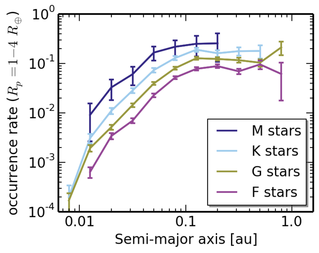
The Kepler Spacecraft has discovered that most stars harbor Earth to Neptune-sized planets at orbital periods less than a year, challenging current theories of planet formation. In this paper, we have explored how the properties of these planets vary with the mass of their host star, and how these properties may inform planet formation theories by linking them to the scaling laws observed in protoplanetary disks.
Kepler has observed stars from spectral type M to F, covering about a factor of three in stellar mass. I have written a code to calculate the true occurrence of planets taking into account various observational biases, in particular the stellar properties.
We find that lower mass stars harbor planets more frequently: low-mass M stars have double the amount of Earth to Neptune-sized planets as G stars, a feature currently not predicted by planet formation models. We also find that the population of planets around low-mass stars extends closer in to their host stars. This trend matches the inner boundary of the gas in protoplanetary disks, suggesting planets migrate to their current locations and get trapped, rather than form in-situ.
link: Mulders et al. 2015 (arXiv)
press release
Kepler has observed stars from spectral type M to F, covering about a factor of three in stellar mass. I have written a code to calculate the true occurrence of planets taking into account various observational biases, in particular the stellar properties.
We find that lower mass stars harbor planets more frequently: low-mass M stars have double the amount of Earth to Neptune-sized planets as G stars, a feature currently not predicted by planet formation models. We also find that the population of planets around low-mass stars extends closer in to their host stars. This trend matches the inner boundary of the gas in protoplanetary disks, suggesting planets migrate to their current locations and get trapped, rather than form in-situ.
link: Mulders et al. 2015 (arXiv)
press release

 RSS Feed
RSS Feed
